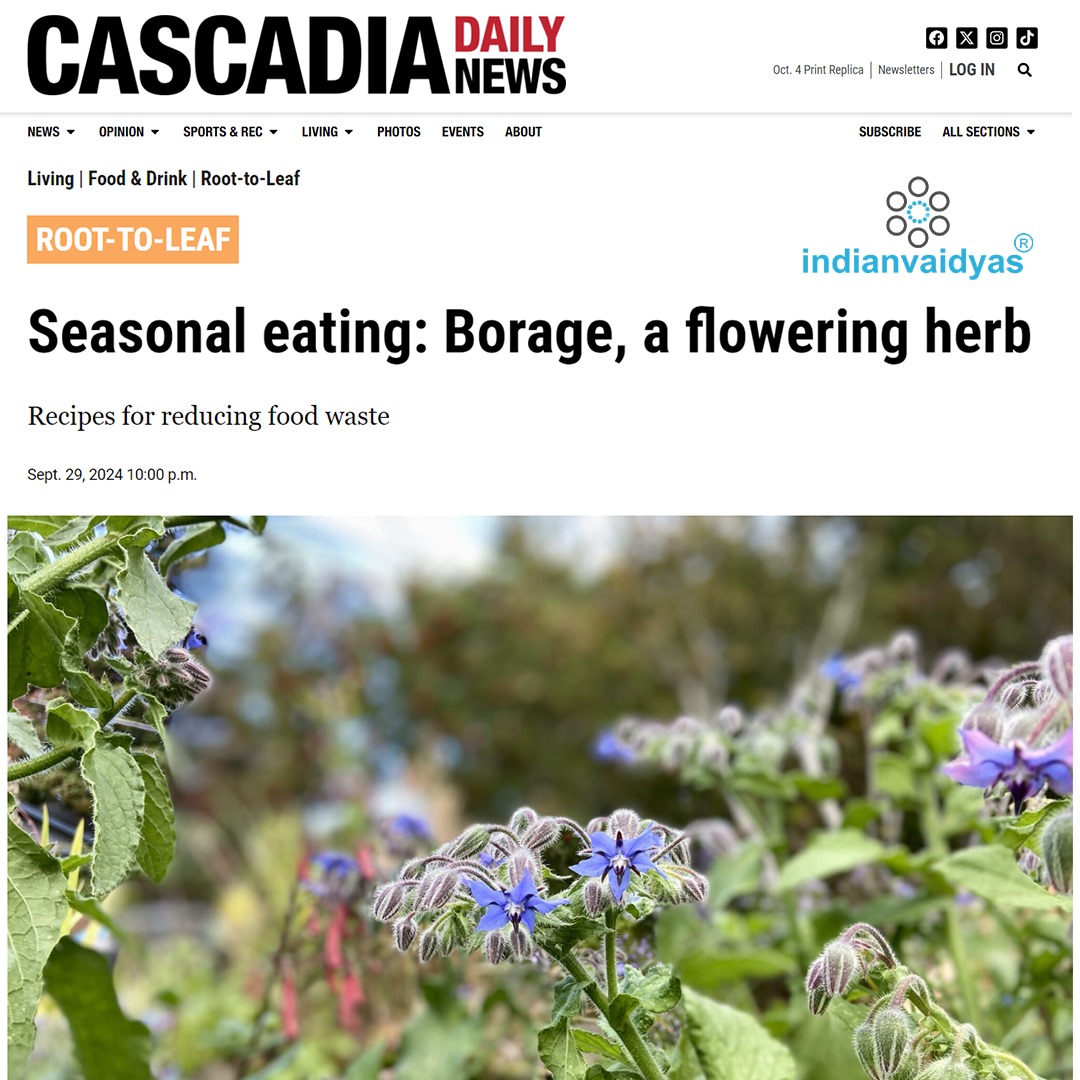Seasonal eating: Borage, a flowering herb
05-Oct-24 06:09:34

It’s amazing that even on the eve of October, this beautiful region we live in is in bloom. A fall crop of garden vegetables — lettuce, cabbage, peas, radishes, sorrel — shows in bold brushstrokes of lush greens and wine-dark purples throughout our neighborhoods. Bursts of chive blossoms and aster spring up under tree canopies of red and orange leaves. And borage, with its bright green leaves and delicate periwinkle blue blossoms, is just as lovely and flourishing today as it was in April.
Borage, though an annual plant, is wildly successful at self-seeding. Many volunteer borage plants have popped up in my yard this year. But a plant as useful and attractive as borage can never be called a weed. It’s an amazing pollinator plant, attracting native bees, beneficial insects, butterflies and hummingbirds. It’s a friendly companion plant for tomatoes, beans, peas, squash and cucumbers, warding off cabbage worms and tomato hornworms, even deterring slugs and snails. And — drumroll, please — it’s fully edible for humans, too.
In fact, borage is a near-perfect example of true root-to-leaf cooking, which uses all edible parts of the plant, keeping in tune with in-season, locally grown produce. Though the flowers are the main attraction, borage leaves and stalks are safe to eat, too. The flavor is herbal and cooling, similar to cucumber or very mild arugula. Though you can eat these raw, the stems and leaves have a slightly hairy texture, and mature plants can be spiny.
If you find a young plant, you’ll only need to blanch the leaves and stems before eating them. And if you really want an adventure with a mature borage plant, cook the stems and leaves thoroughly, until the greens are fully softened. Frankly, mature borage plants are much more useful and enjoyable as garden ornaments than as plated delicacies, but it’s good to know what foods are hiding in plain sight.
As it is with bees, the real draw for us is the borage flowers. These dainty, star-shaped blossoms have an intriguing, delicate flavor remarkably similar to cucumber, and their vivid periwinkle blue makes for a striking presentation. Unlike the leaves and stems, the flowers are best enjoyed fresh, though the flowers are well adapted to a few cooked recipes as well.
Always clean the flowers before you consume them. Being mindful of visiting bees, pick a handful right before you intend to use them. Avoid running the blossoms under water, which could damage the petals. Instead, fill a small bowl with cool water and drop the flowers in. Swish them around gently to dislodge any dirt or natural debris, then remove them from the water and lay them out to dry in a single layer on a clean kitchen towel.
Borage flowers as garnish
The easiest way to eat borage? Treat it like a garnish. Leafy green salads are a natural choice, elevated by pops of blue and bursts of flavor. Why not try an all-blue salad? Silvery blue baby kale, blueberries, blue cheese, purple-blue fingerling potatoes and, of course, borage, are fun ingredients to harmonize for variations on a theme.
Sprinkle the flowers over zucchini ribbons, cucumber noodles or asparagus with hollandaise. Spread thick yogurt or labneh over a serving dish and layer with shaved radishes, thinly sliced scallions and borage flowers for a beautiful accompaniment to pillowy pita or naan. Drop a few flowers atop goat cheese crostini, or float the flowers in a puddle of olive oil to serve with table bread. Make honeydew melon granita and serve with a smattering of flowers — the pale green of the honeydew looks like magic with the pale blue of the flowers.
Borage flowers as ingredients
Use borage as you would cucumber. Lightly fold into cream cheese to use as a sandwich filling (especially good with watercress). Make gorgeous compound butters. Stir it into chilled green gazpacho along with minced cucumber, jalapeno and avocado. Blend up borage chimichurri with garlic and fresh oregano and spoon over salmon, butternut squash or vegetable kebabs.
Borage flowers to steal the show
As with any edible flower, you can use borage in baking and doughs. Arrange the flowers on top of fresh focaccia dough before baking for an edible arrangement. When rolling pasta dough, gently press borage flowers into the top of the dough before slicing and cooking. These are especially good when pressed into dough for ravioli, which you can fill with ricotta, lemon zest, pesto or other bright, herbal sauces and mild cheeses. Cut pressed borage pasta into linguini and toss with asparagus, green peas, artichokes or shaved zucchini. Or drop them onto just-poured glaze for lemon loaf, shortbread cookies or elderflower pound cake for pretty-as-a-picture desserts.
With borage in full bloom across Whatcom County, you can pick your fill of these gorgeous flowers, enjoying them from appetizer to main dishes and through dessert.
NEWS & CREDIT: CASACADIA DAILY